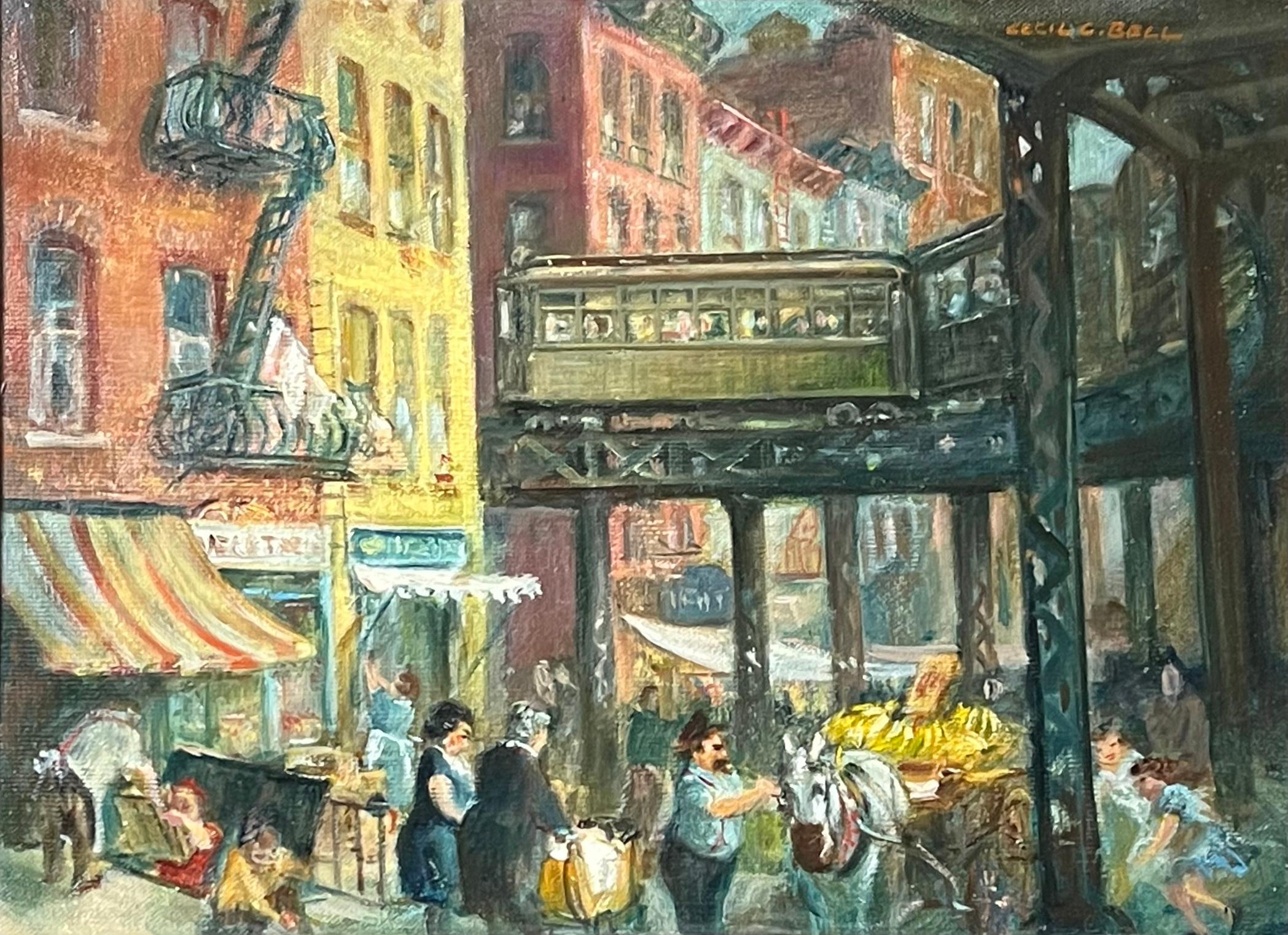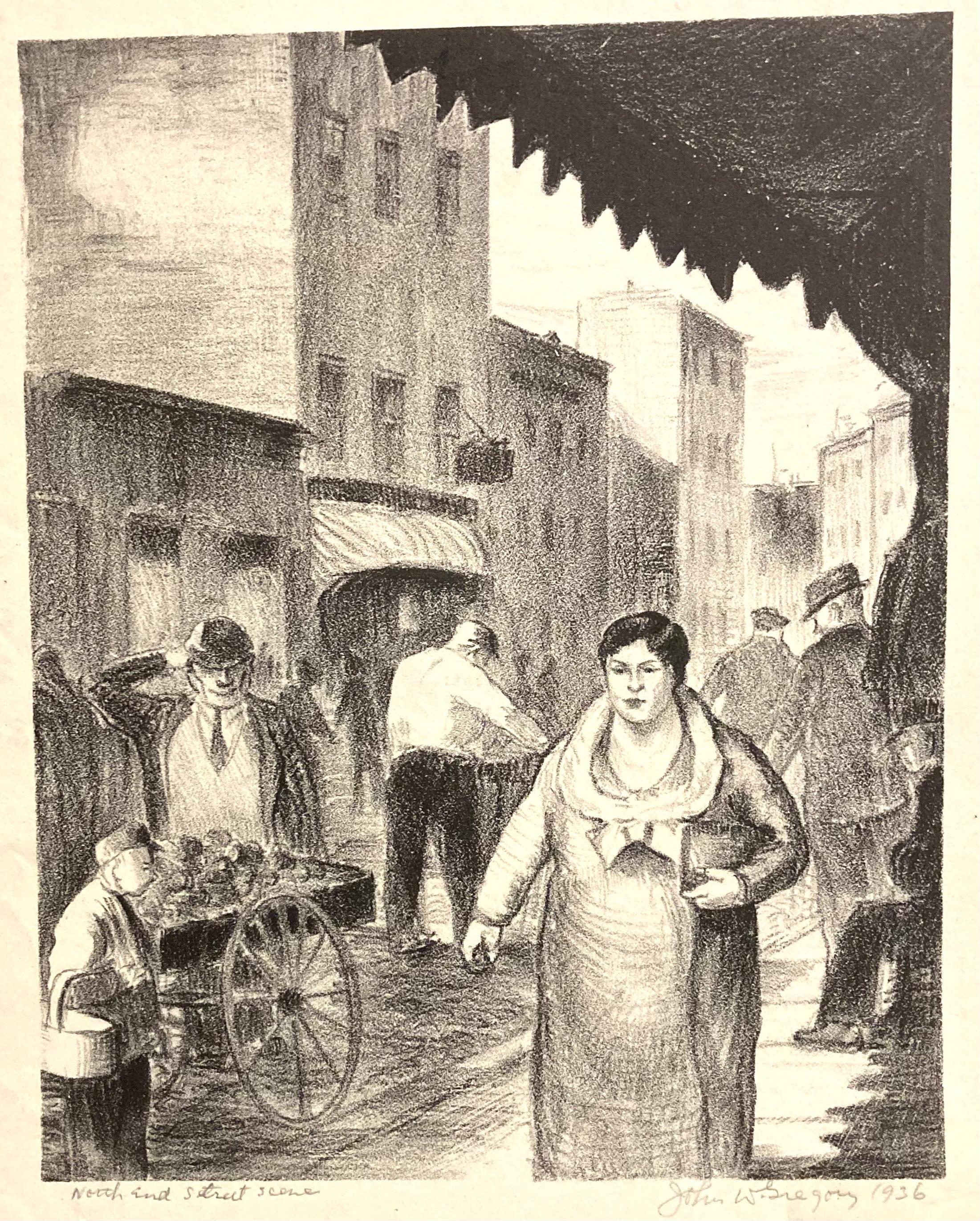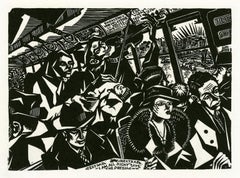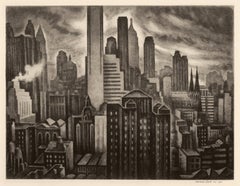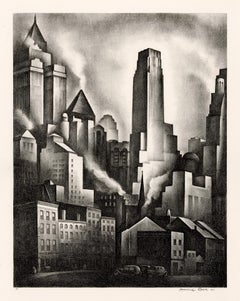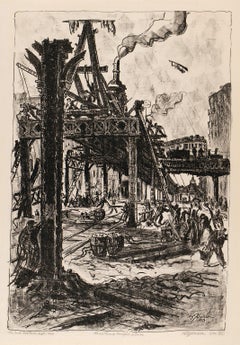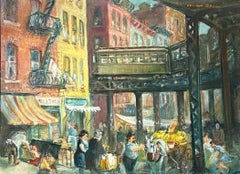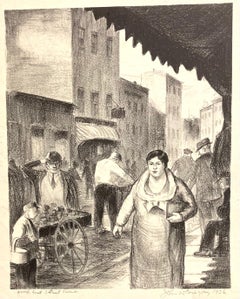Items Similar to 'Hurdy Gurdy Ballet' — New York City American Scene, Ashcan School
Want more images or videos?
Request additional images or videos from the seller
1 of 6
Glenn O. Coleman'Hurdy Gurdy Ballet' — New York City American Scene, Ashcan School1928
1928
$3,840
$4,80020% Off
£2,929.03
£3,661.2820% Off
€3,342.59
€4,178.2420% Off
CA$5,400.05
CA$6,750.0620% Off
A$5,926.68
A$7,408.3520% Off
CHF 3,114.56
CHF 3,893.2020% Off
MX$70,526.28
MX$88,157.8620% Off
NOK 39,813.29
NOK 49,766.6220% Off
SEK 36,381.47
SEK 45,476.8420% Off
DKK 24,972.49
DKK 31,215.6120% Off
About the Item
Glenn O. Coleman, 'Hurdy Gurdy Ballet', lithograph 1928, edition 50. Signed, dated, and numbered '14/50' in pencil. Titled in the bottom left margin, in another hand. Numbered '14' in the lower right sheet edge, in pencil. A fine, richly-inked impression, on cream wove paper, with wide margins (1 1/4 to 2 1/8 inches), in excellent condition. Archivally matted to museum standards, unframed.
Image size 12 1/8 x 15 15/16 inches (308 x 405 mm); sheet size 15 1/2 x 20 1/8 inches (394 x 511 mm).
From the portfolio 'Lithographs of New York' — 12 lithographs printed by master lithographer George C. Miller, exhibited at the Whitney Studio Galleries, November 1- 24, 1928.
Exhibited: 'A Century of Creativity: The MacDowell Colony,' 1907-2007, Library of Congress, February – August 2007. 'Life of the People: realist prints and drawings from the Ben and Beatrice Goldstein Collection,' 1912-1948, Library of Congress, 1999.
Impressions of this work are held in the collections of the Addison Gallery of American Art, Brooklyn Museum, Detroit Institute of Arts, Philadelphia Museum of Art, Library of Congress, The Phillips Collection, and the Whitney Museum of American Art.
ABOUT THE ARTIST
Glenn O. Coleman’s career (1887-1932) as a celebrated New York illustrator, painter, and printmaker was a short one. Born in Ohio in 1887, he grew up in Indiana and moved to Manhattan in 1905 to attend the New York School of Art, studying under William Merritt Chase, Robert Henri, and Everett Shinn.
Coleman earned a name for himself in the 1910s and 1920s New York City art scene with his humanist depictions of street life and working-class people. His illustrations (some of which he produced as lithographs) and paintings reflected the subject matter of his Ashcan teachers: Bowery bums, election night bonfires, slum kids, cops, criminals, “silk-hatted tourists,” bar stool sitters, and other denizens of Lower Manhattan’s corners and hidden enclaves.
In 1910, Henri said this about Coleman, who was exhibiting a series of drawings in New York called 'Scenes From the Life of the People': “This work of Coleman’s is no confection of art junk….It is the record of a certain life drama going on about us here in New York—one side, very grim—a side shunned by many, but one he has looked upon frankly with open eyes and has understood as the thinker with human sympathy understands.”
Coleman stated that his art is inspired by his personal vision of beauty, “Sometimes it is a mad beauty, sometimes a powerful and terrible beauty, sometimes a happy and refreshing beauty. I do not think one thing is more beautiful than another, that is, when I see each thing in its own place.”
A contributor to the socialist journal 'The Masses' and participant of the groundbreaking Armory Show in 1913, Coleman exhibited widely, but he was never very financially successful. “He gained first-hand acquaintance with the experience of the urban poor: often penniless, he frequently was forced to forgo painting in order to work menial jobs to support himself,” according to Fine Art Limited.
“In the mid-1920s, Coleman’s focus as a painter shifted away from the social environment of the city toward a preoccupation with such formal concerns as the geometry of its massive new architecture,” wrote Fine Arts Limited. “Just as his paintings assumed a more modernist style, however, he returned to his earliest sketches of the city as a basis for a series of more conventionally realistic lithographs that celebrate street life and the city’s ordinary inhabitants.”
In the 1920s, he relocated to Long Beach on Long Island, continuing to paint his inspired depictions of New York City. His work won prizes and was acquired by museums like the Brooklyn Museum and the Whitney Museum of American Art. In a 1910 magazine article, Coleman said: “My pictures may not be exactly like New York life really is—photographically speaking. Who really knows how New York life really is? I have my vision of it, my thoughts, my ideas of it….So these masks of men and women—these disguises of men and women, these curious shapes and forms, these shadows and masses of buildings are images always on my mind and out of these images my pictures are made because they are wonderfully absorbing to me, and because they have this terrible energy of New York life.”
Five months after his death in 1932 the Whitney Museum of American Art held a memorial exhibition of Coleman's oils, gouaches, drawings and lithographs to critical acclaim. The exhibition catalog included appreciations by Stuart Davis, John Sloan, and Guy Pene du Bois
"Coleman was essentially a New Yorker... He remained in this city and never tired of recording —always in his own way and with increasing vigor and beauty of style—the life that went on all about him." —Edward Alden Jewell, New York Times, Oct. 18, 1932.
Coleman's graphic works are held in the collections of the Amon Carter Museum of American Art, Art Institute of Chicago, Detroit Museum of Art, Brooklyn Museum, Philadelphia Museum of Art, Metropolitan Museum of Art, Phillips Collection, Princeton University, Smithsonian American Art Museum, Saint Louis Art Museum, Terra Foundation of American Art, and the Whitney Museum of American Art,
- Creator:Glenn O. Coleman (1887 - 1932, American)
- Creation Year:1928
- Dimensions:Height: 12.13 in (30.82 cm)Width: 15.94 in (40.49 cm)
- Medium:
- Movement & Style:
- Period:
- Condition:
- Gallery Location:Myrtle Beach, SC
- Reference Number:Seller: 1036111stDibs: LU53239009692
About the Seller
5.0
Recognized Seller
These prestigious sellers are industry leaders and represent the highest echelon for item quality and design.
Platinum Seller
Premium sellers with a 4.7+ rating and 24-hour response times
Established in 1995
1stDibs seller since 2016
334 sales on 1stDibs
Typical response time: 1 hour
Associations
International Fine Print Dealers Association
- ShippingRetrieving quote...Shipping from: Myrtle Beach, SC
- Return Policy
More From This Seller
View All'Modern Music' — WPA Modernism, New York City El
Located in Myrtle Beach, SC
Albert Potter, 'Modern Music' also Twilight Melodies', linocut, c. 1935, from the posthumous edition of 20, printed in 1977, authorized by the artist’s widow. Estate authenticated in...
Category
1930s American Modern Figurative Prints
Materials
Linocut
'Soaring New York' — 1930s American Modernism, New York City
By Howard Norton Cook
Located in Myrtle Beach, SC
Howard Cook, 'Soaring New York', aquatint, soft-ground etching, roulette, 1931-32, edition 25, Duffy 165. Signed, dated, and annotated 'imp' in pencil. A superb, richly-inked, atmosp...
Category
1930s American Modern Figurative Prints
Materials
Etching, Aquatint
'Financial District', New York City — American Modernism
By Howard Norton Cook
Located in Myrtle Beach, SC
Howard Cook, 'Financial District', lithograph, 1931, edition 75, Duffy 155. A fine, richly-inked impression, on cream wove paper, the full sheet with wide margins (2 3/4 to 5 5/8 inches), in excellent condition. Image size 13 5/16 x 10 3/8 inches (338 x 264 mm); sheet size 23 x 16 inches (584 x 406 mm). Matted to museum standards, unframed.
Literature: 'American Master Prints from the Betty and Douglas Duffy Collection', the Trust for Museum Exhibitions, Washington, D.C., 1987.
Collections: Crystal Bridges Museum of American Art, Library of Congress, Metropolitan Museum of Art, Philadelphia Museum of Art, Smithsonian American Art Museum.
ABOUT THE ARTIST
Howard Norton Cook (1901-1980) was one of the best-known of the second generation of artists who moved to Taos. A native of Massachusetts, he studied at the Art Students League in New York City and at the Woodstock Art Colony. Beginning his association with Taos in 1926, he became a resident of the community in the 1930s. During his career, he received two Guggenheim Fellowships and was elected an Academician in the National Academy of Design. He earned a national reputation as a painter, muralist, and printmaker.
Cook’s work in the print mediums received acclaim early in his career with one-person exhibitions at the Denver Art Museum (1927) and the Museum of New Mexico (1928). He received numerous honors and awards over the years, including selection in best-of-the-year exhibitions sponsored by the American Institute of Graphics Arts, the Brooklyn Museum, the Society of American Etchers, and the Philadelphia Print Club. His first Guggenheim Fellowship took him to Taxco, Mexico in 1932 and 1933; his second in the following year enabled him to travel through the American South and Southwest.
Cook painted murals for the Public Works of Art Project in 1933 and the Treasury Departments Art Program in 1935. The latter project, completed in Pittsburgh, received a Gold Medal from the Architectural League of New York. One of his most acclaimed commissions was a mural in the San Antonio Post Office in 1937.
He and Barbara Latham settled in Talpa, south of Taos, in 1938 and remained there for over three decades. Cook volunteered in World War II as an Artist War Correspondent for the US Navy, where he was deployed in the Pacific. In 1943 he was appointed Leader of a War Art Unit...
Category
1930s American Modern Figurative Prints
Materials
Lithograph
'The Sixth Avenue Spur, New York City '— American Expressionism
By Frederick K. Detwiller
Located in Myrtle Beach, SC
Frederick K. Detwiller, 'The Sixth Avenue Spur, New York City', lithograph, 1924, edition 20. Signed, dated, titled, and annotated 'Lith 20' in pencil. Inscribed 'To my Friend Herbert L. Jones' in pencil. Signed and dated, in the stone, lower right; initialed and dated '1927' in the stone, lower left. A fine, richly-inked impression, on cream wove paper, with margins (7/8 to 1 1/4 inches); slight toning in the top left sheet edge, otherwise in good condition. Scarce.
Image size 20 1/2 x 14 inches (521 x 356 mm); sheet size 22 1/2 x 16 inches (572 x 406 mm). Archivally matted to museum standards, unframed.
ABOUT THE IMAGE
The Sixth Avenue El was constructed in the late 1870s by the Gilbert Elevated Railway and reorganized as the Metropolitan Elevated Railway. By 1878, it was running from Rector Street to 58th Street. Soon after that, it was taken over by the Manhattan Railway Company, with three other Manhattan elevated train lines. The company built a connection, the ‘spur’ by which it turned west on 53rd Street to merge with the 9th Avenue El—paralleling the present-day route of the 6th Avenue subway.
The Sixth Avenue El served the “Ladies Mile” shops (including the Siegel-Cooper emporium, whose building now houses Bed...
Category
1920s Ashcan School Figurative Prints
Materials
Lithograph
'To Market, to Market' — Surrealist Fantasy
Located in Myrtle Beach, SC
Zena Kavin, 'To Market, to Market', lithograph, c. 1935, edition 20. Signed, titled, and numbered '6/20' in pencil. A fine, richly-inked impression, on cream wove paper, with full ma...
Category
1930s American Modern Figurative Prints
Materials
Lithograph
$360 Sale Price
20% Off
'Times Square' — 1920s Modernism
By Adriaan Lubbers
Located in Myrtle Beach, SC
Adriaan Lubbers, 'Times Square', lithograph, 1929, edition 50. Signed, dated, titled, and editioned '(50)' in pencil. A fine impression, on cream wove paper, with full margins (2 1/2...
Category
1920s Modern Figurative Prints
Materials
Lithograph
You May Also Like
Norman Barr, Delancey Street (NYC)
By Norman Barr
Located in New York, NY
Norman Barr recorded his beloved New York City from the Bronx, to Coney Island, to the Fulton Fish Market.
In this period he was on the New Deal's Mural ...
Category
Mid-20th Century Ashcan School Figurative Drawings and Watercolors
Materials
Crayon, India Ink
NYC EL American Scene Social Realism Mid 20th Century Modern WPA Era Figurative
By Cecil Crosley Bell
Located in New York, NY
NYC EL American Scene Social Realism Mid 20th Century Modern WPA Era Figurative
Cecil Bell (1906 – 1970)
Street Life Under the EL
22 x 30 inches
Oil on canvas, c. 1930s
Signed upper...
Category
1930s American Realist Landscape Paintings
Materials
Canvas, Oil
Black Broadway Street Dancers
Located in Wilton Manors, FL
Beautiful WPA era NYC street scene by American artist, Albert Sway (b.1913). Jiggers on Broadway, ca. 1935. Lithograph on paper, image measures 9 x 13 inches. Full sheet measuring 11...
Category
1930s American Realist Figurative Prints
Materials
Paper, Ink
John W. Gregory, North End Street Scene (Boston)
By John W. Gregory
Located in New York, NY
Boston's North End is a charming Italian neighborhood with small buildings and twisting streets. The artist, John W. Gregory, captures the feeling of a pleasant afternoon visiting th...
Category
1930s Ashcan School Landscape Prints
Materials
Lithograph
American Scene Social Realism Mid-20th Century WPA Era Woman Artist Children
Located in New York, NY
American Scene Social Realism Mid-20th Century WPA Era Woman Artist Children
Winnie Borne Sherman (1902-2004)
“Ring around the Rosie”
Pencil on Paperboard, c. 1930s
13 3/8 H x 15 5...
Category
1930s American Realist Figurative Drawings and Watercolors
Materials
Graphite, Board
Norman Barr, Fulton St. Fish Market (NYC)
By Norman Barr
Located in New York, NY
Norman Barr recorded his beloved New York City from the Bronx, to Coney Island, to the Fulton Fish Market.
Although Barr was on the Mural Project of the ...
Category
Mid-20th Century Ashcan School Figurative Prints
Materials
Lithograph
